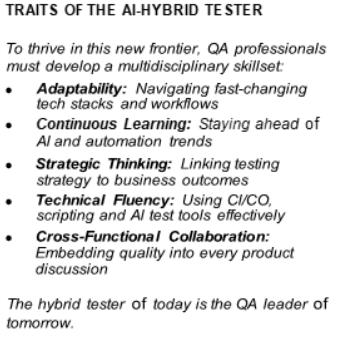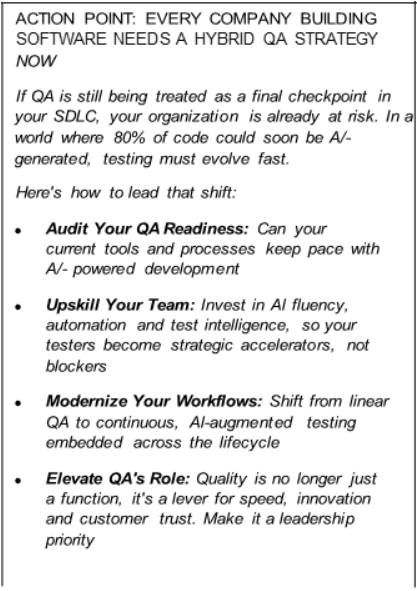In a world increasingly shaped by AI, the rules of software development are undergoing a shift. As organizations accelerate digital transformation, the pace of software production is staggering — more than 500 million new applications are built globally each year; by 2030, this number will be nearly one billion. Yet, the workforce (quality assurance (QA) professionals) tasked with ensuring these applications are functional, scalable and reliable remains drastically under-equipped. At present, there are only 1.5 to 2 million QA testers worldwide. Even if we are optimistic about automation, the gap only continues to grow.
We believe this mismatch in scale presents not only a resource crisis but it also signals a fundamental shift in how we define software quality in this age of Al.
From Manual to Machine-Enhanced: The Rise of the Hybrid QA
To bridge this gap, a new breed of professionals is emerging: The hybrid tester.
These individuals combine the intuition and contextual awareness of human testers with the speed and scale that AI-powered automation brings. They are not just fixing bugs, they are crafting smarter testing strategies that boost coverage, reduce risk and accelerate delivery in an AI-driven world.
Today, over 80% of technology companies have adopted automation-first strategies. However, the frontrunners are taking it a step further: They are building hybrid QA teams that integrate Al at every stage of testing — from intelligent test generation and coverage optimization to continuous improvement and explainability.

Quality at the Speed of Al
Today the game has changed — Al is generating code at lightning speed and traditional QA methods simply can’t keep up. Here’s where hybrid testers step in — adaptable, forward-thinking professionals who combine technical skills with sharp problem-solving capabilities — ensuring quality remains strong, even as innovation accelerates.
These professionals are adept at identifying issues quickly, optimizing test coverage and keeping quality aligned with real user behavior. Be it accelerating releases in agile teams or scaling test orchestration in enterprise pipelines, hybrid testers are shaping QA, bringing speed, intelligence and forward thinking to the heart of software quality.

According to our recent survey findings in KataIon’s 2025 State of Software Quality Report:
High-maturity QA teams are:
- 1.3x more likely to use Al for test optimization
- 1.8x more likely to deploy Al for intelligent test maintenance
A Call to the Industry: Evolve or Be Left Behind
We believe Al isn’t just changing how software is built — it is reshaping the very foundation of quality assurance. In this new era, scaling QA isn’t about adding headcount; it’s about multiplying impact.
That’s the promise of the hybrid tester. These professionals not only keep up with Al, but they also team up with it.
The opportunity is massive — it’s an inflection point for QA. The global software testing market is projected to reach $70–80 billion by 2030. But it won’t be powered by more manual testers; it will be led by AI-augmented human-led approaches that scale quality at the speed of development.

Hybrid testers are at the center of that shift. They transform QA from a reactive function into a strategic engine for speed, resilience and user trust.
The organizations that invest in hybrid QA today will lead tomorrow. The rest? They’ll be testing manually in a world where code is flying out at machine speed.




